 |
| Edward Smith Stanley, 12th Earl of Derby, by George Keating published by William Austin, after Thomas Gainsborough mezzotint, published 20 May 1785 © NPG D35034 |
Edward Smith Stanley, 12th Earl of Derby (12 September 1752 – 21 October 1834) is best remembered for his passion for sport. Two of the British classic horse races still commemorate that passion – the Epsom Derby, named after him, and the Epsom Oaks, named after his hunting lodge, The Oaks, where both races were conceived.
You can read about The Oaks here.
You can read about The Oaks here.
Early years
Edward Smith Stanley was born in Preston, Lancashire, on 12 September 1752, the eldest son of James Stanley, Lord Strange, (1716-71) and Lucy Smith, the co-heir of Hugh Smith of Weald Hall, Essex , and the grandson of Edward Stanley, 11th Earl of Derby (1689-1776). Lord Strange added the name Smith to his own in 1749 by Act of Parliament.
Edward was educated at Preston Grammar School and then Eton College before going up to Trinity College, Cambridge, in 1771, where he was awarded a degree of Master of Arts in 1773.
Becoming Lord Stanley
Confusingly, on the death of his father on 1 June 1771, Edward assumed the title of Lord Stanley and not Lord Strange. The Gentleman’s Magazine for 1834 explained that he assumed the title of Lord Stanley
… it having been ascertained, after the title of Strange had been first adopted for his father, that that barony was really vested in the Duke of Atholl, the heir-general of James 7th Earl of Derby, and not in the junior male line of Stanley, to which the Earldom had devolved.1
Edward became the 12th Earl of Derby on the death of his grandfather on 22 February 1776.
An illustrious but disastrous marriage
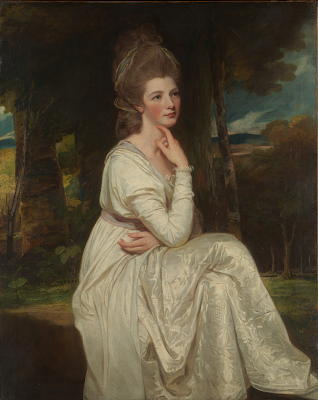 |
| Elizabeth Stanley (née Hamilton), Countess of Derby by George Romney (1776-8) DP162156 from Metropolitan Museum of Art |
To celebrate the occasion, a superb outdoor entertainment – known as a fête champêtre - was held at his country residence, The Oaks, on 9 June. An elaborate temporary pavilion designed by Robert Adam was built in the grounds for the celebration.
You can read more about the fête champêtre in my post on The Oaks.
Edward and Betty had three children: Edward, 13th Earl of Derby (1775), Charlotte (1776) and Elizabeth Henrietta (1778).
The marriage was not a happy one and in the late 1770s, Betty embarked upon a scandalous affair with John Frederick Sackville, 3rd Duke of Dorset. After the birth of her daughter Elizabeth, who may have been fathered by the Duke, Betty left her husband and children for her lover. The Earl, however, refused to divorce his wife.
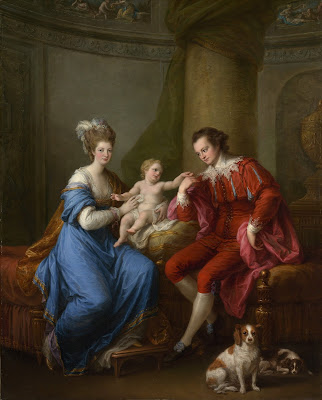 |
| Edward Smith Stanley, 12th Earl of Derby, with his wife, Lady Elizabeth Hamilton, and their son Edward by Angelica Kauffmann (c1776) DP169403 from Metropolitan Museum of Art |
A happy second marriage
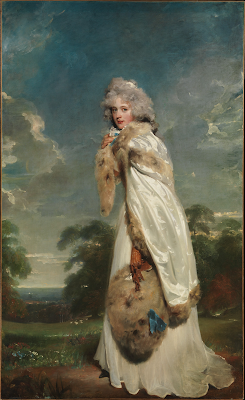 |
| Elizabeth Farren, later Countess of Derby by Sir Thomas Lawrence (1790) from Metropolitan Museum of Art |
Edward was MP for Lancashire from 1774 until he was elevated to the House of Lords in 1776 on inheriting the earldom.
Influenced by his uncle, John Burgoyne, and his close friend Charles James Fox, he switched political allegiance to the Whig opposition in 1778. He had two brief periods of office as Chancellor of the Duchy of Lancaster in 1783 and again in 1806-7.
He was made Lord Lieutenant of Lancashire in 1776 – a role which he reportedly did well and held until his death.
Gambling and sport
Edward was an inveterate gambler who was obsessed with sport. He was ‘a devotee of cricket and hunting as well as racing and cockfighting.’2
His obituary in the Gentleman’s Magazine (1834) said:
It was, however, in the character of a sportsman that the late Earl made himself most conspicuous; and a passion for horse-racing and cock-fighting was the absorbing one of his life. He possessed the reputation of having the best breed of cocks in England. For some years past, indeed ever since Liverpool has had a race-course, he personally attended the meetings, and took the most lively interest in the matches of his horses and cocks, more especially the latter. General Yates, whose breed of cocks was also celebrated, was his invariable opponent, and they annually decided the question of their respective game by a match of a thousand guineas aside. So strong was the Earl’s addiction of his favourite sport, that cocks have been introduced into his drawing-room, armed and spurred, even during the latter days of his life.3
The Derby and the Oaks
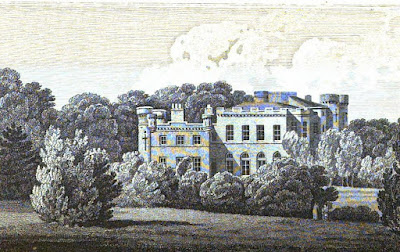 |
| The Oaks from London by D Hughson Volume V (1808) |
The following year, he and Sir Charles Bunbury conceived another race for three-year-olds to be run at Epsom. Reportedly, they tossed for the name and Edward won, so it was named for him – the Derby Stakes. Bunbury’s Diomed was the first winner; Edward’s Sir Peter Teazle won in 1787.
The Oxford Dictionary of National Biography entry on the 12th Earl of Derby stated:
His influence on the development and organisation of English horse-racing, as well as its annual social calendar, was of great and lasting significance.4
Death
In later years, Edward extended his estates in Liverpool, Bootle and Bury, and made improvements to the stables and park at his ancestral home of Knowsley Hall, in Lancashire. He died at Knowsley on 21 October 1834 and was buried at Ormskirk, next to his second wife, who had died previously, on 23 April 1829.
 |
| Knowsley Hall, Lancashire (2011) CC 2.0 Jack via Flickr |
Notes
1. Gentleman’s Magazine (1834).
2. Crosby, Alan G, Stanley, Edward Smith, 12th Earl of Derby (1752-1834), Oxford Dictionary of National Biography (2004).
3. Gentleman’s Magazine (1834).
4. Crosby op cit.
Sources used include:
Burgoyne, John, The Maid of the Oaks: A new dramatic entertainment. As it is performed at the Theatre-Royal, in Drury-Lane (1775)
Crosby, Alan G, Stanley, Edward Smith, 12th Earl of Derby (1752-1834), Oxford Dictionary of National Biography (Oxford University Press, 2004; online edn Sept 2004, accessed 29 May 2018)
Debrett, John, The Peerage of the United Kingdom of Great Britain and Ireland (1820)
Draper, P, The House of Stanley (1864)
Gentleman’s Magazine (1834)
Hughson, David, London; being an accurate history and description of the British Metropolis and its neighbourhood Volume V (1808)
Prosser, George Frederick, Select Illustrations of the County of Surrey (1828)

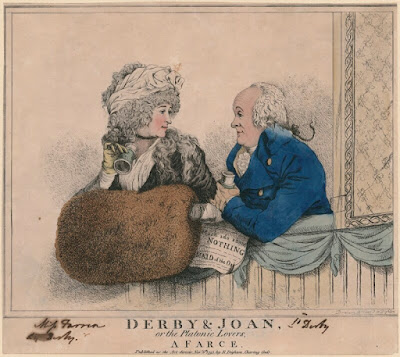
No comments:
Post a Comment